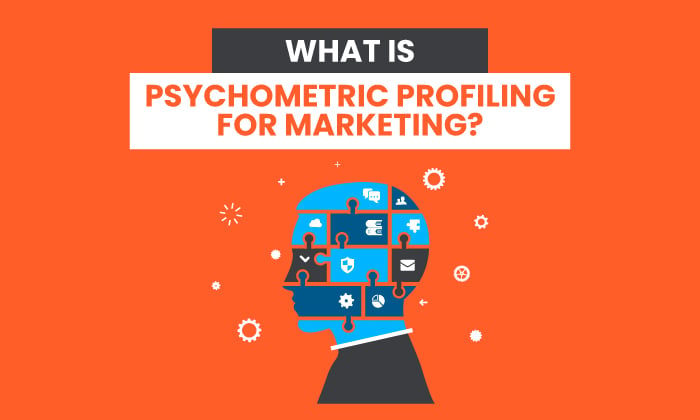
Here’s a question for you: How well do you know your customers?
I ask because the better you understand your customers, the more effectively you can reach them. If you know what makes them tick and what influences their individual buying decisions, you can adapt your marketing strategy to increase conversions.
The answer? Psychometric profiling. Let me show you why it’s such a valuable tool for increasing marketing effectiveness and how you can deploy it across your business.
Psychometric Profiling: How Does It Work?
Psychometric profiling is a measuring tool. It allows you to “measure” someone’s personality and use the findings to develop highly targeted, individualized marketing campaigns.
Did you know that customers prefer personalized messaging? 83 percent of customers are OK sharing data with you if it means a more personalized shopping experience.
The takeaway? Psychometric profiling makes it easier for you to give customers what they want.
To be clear, it’s not the same as demographic profiling. Demographic profiling means categorizing customers based on “generic” measurements, like age and gender. Psychometric profiling offers a new, more diverse way to categorize your audience base. Here’s how it works:
What It Measures
Psychometric profiling measures six things:
- personality traits (openness, conscientiousness, extroversion, agreeableness, neuroticism)
- interests
- lifestyle
- opinions and beliefs
- values
In other words, personality profiling helps you understand why your customers behave the way they do. Once you know what drives people, you can devise highly effective and targeted marketing campaigns.
Building a Psychometric Profile
The data you need to profile your customers and improve your marketing outreach? It’s already out there.
Think about it. Over 4.5 billion people use the internet, including email and web browsing, and roughly half of the world’s population uses social media.
These people are:
- shopping online
- reading marketing emails
- sharing Facebook posts
- following brands on Instagram
- tweeting about things they care about
All of this is data you can use to understand your customers better and discover which marketing strategies they’ll respond to best.
Are There Any Limitations to Psychometric Profiling?
Psychometric profiling helps you connect with your customers, but it has limits like anything.
You still need to collect demographics and other user data for a complete picture. Plus, it’s no substitute for reaching out and engaging with customers directly, for example, on social media. You also can’t use psychometrics to measure marketing performance. In other words, it doesn’t show you whether your strategy’s working or not.
5 Reasons Why Psychometric Profiling Helps Marketers
There’s no such thing as a perfect marketing tool, so don’t let the limitations deter you. Here are five reasons to try it:
Psychometric Profiling Helps You Understand Buyer Intent
Say you own a cosmetics store. Your demographic profiling and analytics testing reveal that your customers are typically middle-class women aged between 21 and 45, and they respond well to promotional emails.
Why, though, did a 21-year-old single woman and 45-year-old mother buy the same cosmetics set at 50 percent off? You won’t know until you profile your customers’ personalities and behavior.
With the help of psychometric profiling, here’s what you might discover:
- Some women bought the set as a gift.
- Others treated themselves “just because.”
- Another group bought the set because their favorite influencer promoted it.
Based on buyer intent, you now have three subgroups:
- gift-givers motivated to buy discounted products
- women who purchase products because they enjoy pampering themselves
- those who try new things to feel part of an in-crowd
Personality profiling fills in the gaps left behind by other analytics tools.
Psychometric Profiling Helps You Improve Conversions
Do you know why you’re losing people at a certain point in a sales funnel? Psychometrics can help you play detective by eliminating some of the guesswork.
If you have assertive, no-nonsense customers who value efficiency, check your page loading speed. Slow loading speeds could be the culprit.
Do your customers love it when companies share their values? Check your copy. Maybe your message is unclear or goes against what your audience believes in.
Psychometrics speeds up your troubleshooting process by helping you pinpoint exactly where the problem lies. The outcome? More conversions and lower abandonment rates.
Psychometric Profiling Helps You Widen Your Social Media Audience
Social media platforms like Facebook let you get pretty specific about who you target. Want to target local moms who love fitness and care about the planet? Facebook’s got you covered.
Using psychometrics, take a look at your followers and delve a little deeper. Let’s stick with our moms for this:
- Chances are if they’re into fitness, they probably care about health and nutrition.
- If they love green products, maybe they care about your attitude toward sustainability.
- Do these moms see themselves as progressive? Reflect their beliefs in your copy.
Take what you discover from profiling to refine your social media ad campaigns and draw in more followers.
Psychometric Profiling Helps You Target Your Marketing Outreach
Harness the power of psychometric profiling to target your marketing outreach.
Those women who buy cosmetics because their favorite influencer promoted it? Use more influencer marketing to reach these customers.
The moms who care about sustainability and green products? Send them emails talking about the eco-friendly causes you support.
Here’s something to think about: 68 percent of customers will shop elsewhere if they feel you don’t care about their business. Target your outreach to show people just how much you value their custom.
Psychometric Profiling Helps You Build a Stronger Brand
Don’t underestimate the power of brand personality. Over 60 percent of men and women prefer brands to build an emotional connection. 77 percent of customers remain loyal to brands that share their values. According to PwC, 64 percent of customers walk away from companies that don’t share their values or political beliefs.
With psychometrics, you can:
- Identify your most loyal customers or followers.
- Profile them based on their personality, beliefs, lifestyle, and values.
- Ensure your branding reflects what your loyal customers want to see.
TALA, a fitness brand, clearly knows its audience base. They’re all about diversity, sustainability, and inclusivity, and they target millennials who love eco-friendly fashion.

Through hashtags and slogans, they reinforce their branding across all platforms, including their website:

Don’t forget their social media:

The takeaway for marketers? TALA understands why its customers shop the way they do and draws in followers through strong, personality-based messaging.
You can do the same.
How to Use Psychometric Profiling in Your Marketing
Don’t let the idea of “profiling” your customers intimidate you. Remember, the information you need is out there already. It’s just a matter of bringing it all together and analyzing the results to improve your marketing strategy.
1. Survey Your Current Audience
Don’t worry; there’s no need to formally interview your top clients or run expensive marketing focus groups. Instead, here’s what you can do.
First, try making casual conversation with your most loyal (or highest-spending) clients. How did they spend their weekend? What matters to them?
The questions you ask vary depending on your consumer base and how you do business. For example, if you don’t have a physical store where you speak with customers, this may be less practical. You could still ask these questions online, though, if your customers respond well to social media engagement.
Next, send out some customer questionnaires and be honest about what you’re doing (remember, transparency is key). Ask them questions like:
- what they care about
- how they prefer communicating with you
- what else they’d like to see from you
Spend some time crafting questionnaires and reflect on the results.
For example, maybe your customers hate marketing emails, but they respond well to social media messaging because they’re friendly and love interacting with businesses. The answer? Send fewer emails and spend more time talking to customers online.
2. Analyze Existing Website Data
Hopefully, you’re already gathering marketing data, whether it’s through A/B testing, Google Analytics, or social media tools like Hootsuite.
Don’t have this data on hand? No worries. You can start now using quick and easy tools like my free A/B testing calculator.
Once you have the data, look at it from a “why” perspective and put yourself in a customer’s shoes. Ask why:
- certain posts get the most interaction
- some emails have great click-through rates
- people drop out your sales funnels at certain points
This approach is great because you’re finding new ways to put existing data to work. It’s efficient and cost-effective.
3. Collate the Data
You’ve got the data, and now it’s time to use it.
The goal here is to create demographic and psychometric profiles to segment your customer base into target groups. Once you have your target groups, you can try out new marketing techniques and refine your outreach strategy.
Think back to our women aged 21-45 who bought the cosmetics set on sale. We categorized them into three separate audiences based on motives, but it’s possible to go deeper.
Use all the tools at your disposal to learn as much about these women as possible. Why do they shop the way they do? Who are they as people, and what drives them?
Try psychometrics tools if you need a little more help, and compile demographic and psychometric data for the most accurate possible profile.
4. Use Tests and Tools
Once you segment your audience, test out new marketing strategies on them. Tweak your plan based on your findings. You can also try these techniques:
- Run different UI flows.
- Make targeted product recommendations to personalize the shopping experience.
- If your customers are extroverted, fun, and friendly, make your sales funnels more engaging.
- Do your customers love to feel like they’re part of something exclusive? Use scarcity tactics to encourage them to buy now.
There’s no right way to do this, so try a few things and see how they affect conversion.
5. Improve Ad Relevance
Use your personality profiles to improve ad quality and relevance.
For example, say your customers are usually middle-aged men who love tinkering with cars. They often work alone, and they have plenty of time on their hands.
Chances are, they’ll respond better to ads showing other middle-aged men working on cars alone in a relaxed environment. Families working on cars together or mechanics racing to get the job done? These images may be less effective.
The more relevant your ad, the better your ad performs, which ultimately helps grow your business.
6. Write More Compelling Emails
Since you now know who your customers are and what they want, you can craft highly relevant and emotionally engaging emails. Here are some tips:
- Analyze your most successful email blasts from a psychometric perspective. Why did customers respond so well?
- Use your findings to replicate these marketing campaigns.
- Try out new techniques (based on your profiling, of course) and analyze performance as you go.
For example, maybe discount codes perform great, and promotional emails less so. What does that reveal about your audience, and how can you integrate this info into your email marketing strategy?
7. Craft New Content
Are you looking for new content ideas? Turn to psychometrics. Here’s an example:
Your followers work in cybersecurity. Through social media and website analytics, you discover they care about general IT trends. They care about IT trends because they’re concerned about how they affect their cybersecurity strategies. Thanks to psychometric profiling, you can tap into these concerns and write new content.
Use psychometrics to cater to a user’s every need.
Conclusion
Psychometric profiling offers a window into your customers’ personalities. It tells you why your audience behaves the way they do, what influences their buying decisions, and, most crucially, what you should do to keep their loyalty.
Want to get the most out of personality profiling? Take the psychometric data you uncover and compile it into your findings from other analytics tools like Ubersuggest to build the richest possible picture of your audience base.
Have you tried psychometric profiling in your marketing strategy? How is it working for you?
The post What is Psychometric Profiling for Marketing? appeared first on Neil Patel.
About us and this blog
We are a digital marketing company with a focus on helping our customers achieve great results across several key areas.
Request a free quote
We offer professional SEO services that help websites increase their organic search score drastically in order to compete for the highest rankings even when it comes to highly competitive keywords.
Subscribe to our newsletter!
More from our blog
See all postsRecent Posts
- Web Hosting September 26, 2023
- Affiliate Management September 26, 2023
- Online Presence Analysis September 26, 2023

